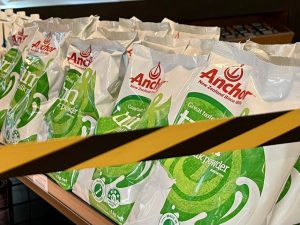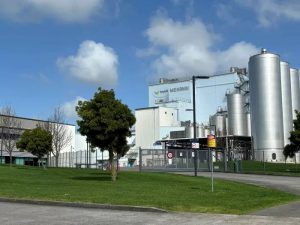
The co-operative on Thursday lifted its forecast for the 2021/22 season a fourth time, and is now expecting to pay its farmer suppliers between $9.30 and $9.90 per kilogram of milk solids. That’s up from its forecast a month ago of between $8.90 and $9.50 per kgMS.
The midpoint of the range, which farmers are paid off, increased by 40 cents to $9.60 per kgMS which would be the highest level since Fonterra was formed in 2001. The co-operative paid farmers $7.54 per kgMS last season, and its previous record was $8.40 per kgMS in the 2013/14 season.
Global dairy prices hit their highest level in almost nine years at auction last week, as tight milk supply stokes demand for New Zealand’s biggest export commodity. Prices have been supported this season by weaker milk production in New Zealand and overseas, hindered by poor weather and higher feed costs.
Fonterra chief executive Miles Hurrell said the forecast upgrade reflects the increase in global dairy prices since the co-operative’s last milk price update in January, and good levels of ongoing global demand for dairy.
Hurrell noted that since the co-operative last revised its forecast, average whole milk powder prices on the Global Dairy Trade auction platform had increased 10.3 per cent, while skim milk powder prices had increased 8.4 per cent. Both products were key drivers of its milk price, he said.
“Global demand for dairy remains firm, while global milk supply growth continues to track below average levels,” Hurrell said. “These demand and supply dynamics are supporting the increase in prices.”
Milk production in the European Union and the United States continued to be impacted by the high cost of feed and this was not expected to change in the coming months, he said.
In New Zealand, challenging weather conditions continued to impact grass growing conditions, which prompted the co-operative to revise down its milk collection forecast for this season by 3.8 per cent to 1,480 million kgMS, compared with last season.
“This reduction in supply reinforces our strategic focus on ensuring our milk is going into the highest value products,” he said.
Hurrell has previously signalled that the world’s biggest dairy exporter would be looking to eke more value out of New Zealand milk as it faces a future with fewer cows.
Strong global demand for New Zealand primary products has helped the economy remain resilient during the Covid-19 pandemic and is helping offset losses from the tourism industry which has been hurt by border closures.
The mid-point of Fonterra’s latest forecast range would inject more than $14b into New Zealand’s economy through milk price payments alone, and would be welcome news for farmers who were facing rising costs on farm, including from inflation and rising interest rates, Hurrell said.
The Reserve Bank on Wednesday raised the benchmark interest rate and signalled interest rates would now be steadily ratcheted up.
Elsewhere, Stats NZ data showed key farm inputs had jumped over the past two years, with electricity costs up 21 per cent, and stock grazing costs up 36.9 per cent, he said.
Higher milk prices can squeeze profit margins for milk processors like Fonterra unless they can sell their products at higher prices as well.
Hurrell said that while the higher forecast farmgate milk price put pressure on Fonterra’s margins in its consumer and foodservice units, prices in its ingredients business remained favourable for milk price and earnings at this stage.
As a result, Fonterra retained its 2021/22 earnings guidance of 25-35 cents per share, he said.
He reiterated that the co-operative would continue to keep a close eye on the potential impact on demand from rising interest rates and inflation, increased potential for volatility as a result of high dairy prices, geopolitical issues and economic disruptions from Covid-19, particularly as governments manage the rapid spread of the Omicron variant.
As the country’s biggest processor, Fonterra’s milk payment sets the benchmark for its competitors.






















